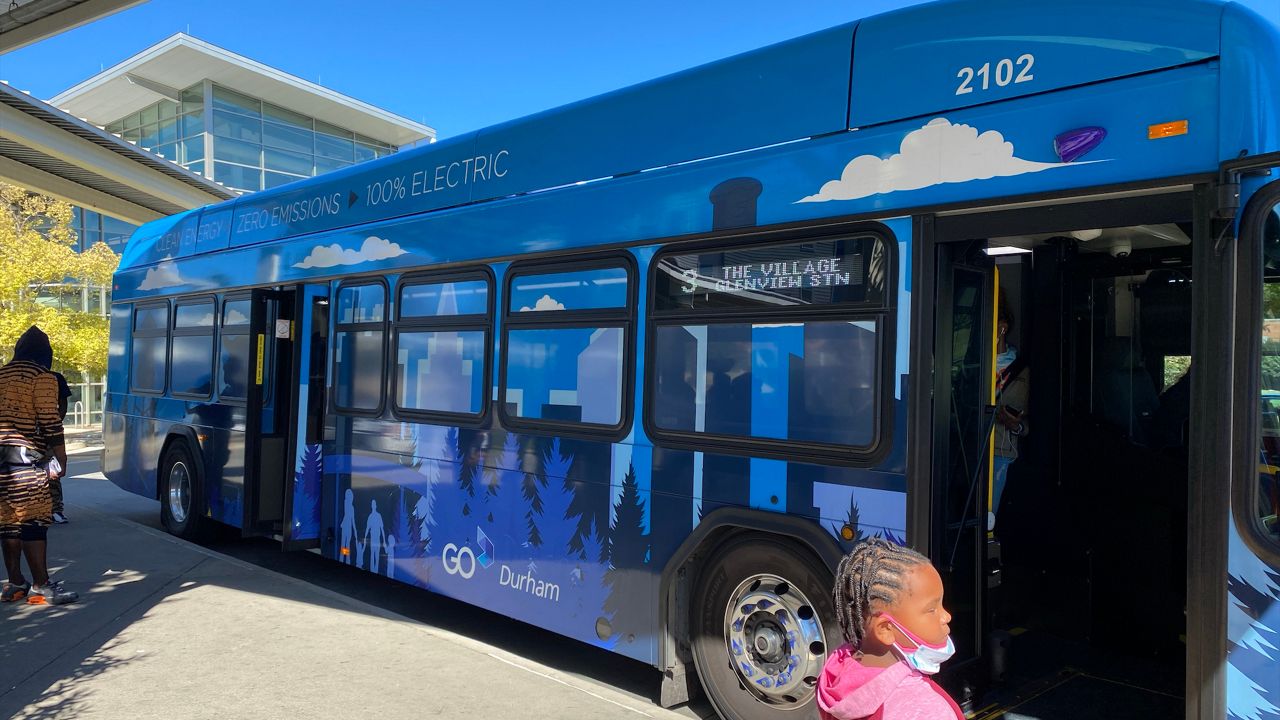DURHAM, N.C. — On any given day, North Carolina's fourth largest city is tackling climate change on multiple fronts.
The climate fight begins before dawn, when drivers like Jena Gibbs warm up one of GoDurham's two electric buses. They are part of an ongoing transition to low-and zero-emission buses. Gibbs said driving electric buses takes some getting used to. Not only are they much quieter than diesels, she said they also are much more responsive.
“If I could drive an electric bus every day and completely dead out diesel, I would,” she said.

It continues into the morning, when urban forester Daniel Hickey leads a team of Durham city workers planting trees in neighborhoods, which historically have lacked tree cover. Hickey said the city has a longstanding policy of replacing every tree it cuts down.
In addition, beginning in 2016, city officials directed crews to plant 1,500 new trees every year through 2025, significantly increasing the city's tree canopy. Besides filtering out air pollution and providing cooling shade, Hickey said trees help reduce stormwater runoff.
“Say this was just pavement instead of grass and a tree, the second it rains, it would run right off that pavement and go to the stormwater, which puts more pressure on our infrastructure for stormwater management,” he said.
Data collected at Raleigh-Durham International Airport show climate change already has had a measurable impact in North Carolina.
Total average annual rainfall in the Triangle has risen by nearly a foot, from 45.64 inches in 1971 to 55.19 inches in 2020, while the mean annual temperature has crept up by 3.5 degrees during the same period, to 62.5 degrees Fahrenheit.
Half a century ago, Durham residents could expect to go an entire year without seeing a day with a high temperature of 95 degrees or greater. By 2021, the Triangle averaged 11 such days per year, an average increase of one additional 95-plus degree day every three years.

Durham is one of several cities in North Carolina that have adopted climate action plans in recent years in response to the climate crisis. Approved by the city council at the end of October, the Bull City's plan calls for carbon neutrality in all city operations by 2040 and 100% use of renewable energy by 2050. That puts it a decade ahead of the deadline state lawmakers approved this fall for carbon neutrality in North Carolina.
Besides planting trees, Durham has already purchased four electric vehicles for city staff use.
Sustainability and energy analyst Paul Cameron said the city eventually will replace all of its gas-powered passenger vehicles and light trucks with electric vehicles. For his part, Cameron said he uses the city's electric cars whenever possible.
“The electric vehicles are just very easy to use. They're quiet, easy to maneuver, they're just a pleasure to drive in every way,” he said. “I'm going to purchase an electric vehicle for my next personal vehicle.”
Electric vehicles play a key role in other cities' climate plans, too.
Chapel Hill's plan sets a goal of a 100% electric fleet by 2050, including heavy-duty vehicles. A draft plan under development in Greensboro recommends an all-electric fleet by 2040. Those cities and others, including Durham, are also adding public electric vehicle charging stations to encourage residents to switch from gas-powered vehicles.
Strategies extend to city-owned buildings as well.
In Charlotte, officials are evaluating ways to retire gas boilers and utilize alternative heating methods as part of that city's plans to make its buildings carbon neutral by 2030. Durham's new water treatment building will use ground source geothermal heat pumps and solar panels to limit its energy use. City climate plans also include provisions for non-city-owned buildings. Raleigh's climate plan recommends incentivizing high-efficiency construction in both residential and commercial buildings.
Despite the enormity of the task, Durham and other cities face, employees like Cameron and Hickey said they consider their roles in the climate plan just part of a day's work.
“If we can do something to mitigate those climate change results by, let's say, planting trees and cooling streets down, I think that's a benefit. It definitely feels good,” Hickey said. “I think our guys are pretty happy about the work they're doing.”



